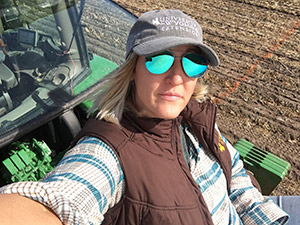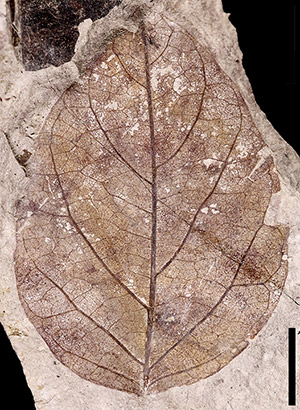
Contact Us
Institutional Communications
Bureau of Mines Building, Room 137
Laramie, WY 82071
Phone: (307) 766-2929
Email: cbaldwin@uwyo.edu
UWs Science Initiative Awards $1 Million in Seed Grants to 13 Faculty Research Projects
Published May 17, 2019

Carrie Eberle, a UW assistant professor of plant sciences, heads one of 13 research
projects funded through $1 million in Science Initiative Faculty Innovation Grants
awarded to interdisciplinary teams of UW faculty. Eberle’s project will look at whether
the plant Crotalaria juncea, also known as sunn hemp, could fit into Wyoming’s short
summer growing window, improve soil health, increase soil nitrogen and be used as
a high-quality, low-cost alternative to alfalfa hay. Here, Eberle is in the midst
of planting winter wheat variety trials. (Carrie Eberle Photo)
Success of the Wyoming crop and livestock industry has been limited by market accessibility, infertile soils, short growing seasons and low availability of high-quality, low-cost animal feed, says Carrie Eberle, a University of Wyoming assistant professor of plant sciences.
But Eberle thinks the plant Crotalaria juncea, also known as sunn hemp -- not to be confused with the recently legalized industrial hemp -- may be an answer to help improve crop output. Sunn hemp is a tropical legume that produces high tonnage biomass in a short time and fixes nitrogen.
Her research project is among 13 headed by UW faculty that will benefit from $1 million in seed grant funding that is part of the university’s Top-Tier Science Initiative. The Science Initiative Faculty Innovation Grants were awarded to interdisciplinary teams of UW faculty. The grants take effect July 1, and are either one- or two-year grants.
“We hypothesize the adoption of this crop into Wyoming systems could fit into the short summer growing window, improve soil health, increase soil nitrogen and be used as a high quality, low-cost alternative to alfalfa hay,” Eberle says. “A knowledge gap exists in how to manage C. juncea for forage harvest, soil improvement properties, yield potential and value as animal feed. With this project, we will establish how irrigation and harvest management affect crop performance and feed quality.”
The goal of the seed grant program is to stimulate new, innovative, cutting-edge research projects in the sciences that have promise for successful, sustained and substantial external competitive funding. The most competitive proposals will address the interdisciplinary nature of the research and will involve research teams of faculty from multiple departments, colleges, fields or disciplines at UW.
“These seed grants are expected to encourage 30-plus competitive grant proposals over the next two years to federal agencies, including the National Science Foundation (NSF), Department of Energy, Department of Defense, United States Department of Agriculture (USDA), National Institutes of Health and United States Geological Survey,” says Tabatha Spencer, senior program coordinator for UW’s Science Initiative.
The UW Science Initiative began in 2014 when former Gov. Matt Mead and the Wyoming Legislature challenged the university to develop a plan to address outdated science laboratories at UW and improve the quality of instruction and research in the sciences. A task force, appointed by Mead and informed by UW faculty representatives, developed a transformational vision for UW’s core science programs in botany, zoology and physiology, molecular biology, chemistry, and physics and astronomy.
The developed plan charts a clear course for these science programs to rise to top-tier status in the nation and builds upon Wyoming’s STEM (science, technology, engineering and mathematics) initiatives; the location of the NCAR-Wyoming Supercomputing Center in Wyoming; the construction of the Michael B. Enzi STEM Facility; and the Wyoming Governor’s Energy, Engineering STEM Integration Task Force.
Ellen Currano, a UW associate professor of botany, also will lead a Wyoming-based research project. She and her team will investigate ecosystems in the Wind River Basin from the Early Eocene climatic optimum, which occurred approximately 48 million-53 million years ago.
“This was the warmest time since the dinosaurs died, when the poles were ice-free and broad-leaved subtropical forests covered Wyoming,” Currano explains. “There are fundamental gaps in our knowledge about how Earth works during these hothouse times and, if we continue to burn fossil fuels unchecked, we are likely headed back to the Eocene. We plan to collect paleontological and geochemical data to better understand climate, forests and microbes in the hothouse.”
Currano hopes that the close collaboration established among three of UW’s five paleontologists on campus will help propel UW to a top-10 national ranking in paleontology. She says the team aspires to follow the model of the University of Cincinnati, which achieved this when its four paleontologists and interdisciplinary collaborators focused research on their local, world-famous marine fossil beds.
“Wyoming has unparalleled Cenozoic terrestrial fossil deposits, and I think we are poised to become one of the premier paleontology programs in the U.S.,” Currano says. “And, yes, we will be using the results of this grant to apply for larger NSF grants.”
UW research projects, listed by titles, the grant amount, the project’s principal investigator (PI), co-PIs and other collaborators, are:
-- “Accelerating the Computational Investigation of Supermassive Sub-Parsecbinary Black Hole Candidates,” $45,000. Mike Brotherton, a professor of physics and astronomy, is the PI on the project. Daniel Dale, a professor of physics and astronomy and associate dean of the College of Arts and Sciences; and Ruben Gamboa, a professor of computer science, will serve as co-PIs. The Chinese Academy of Sciences’ Institute of High Energy Physics will collaborate.
-- “Establishing Crotalaria juncea as a New Forage Crop for the Sustainable Intensification of the Wyoming Agricultural Industry,” $89,992. Eberle is the PI on the project. Steve Paisley, an associate professor and interim director of the Department of Animal Science, is the project’s co-PI.
-- “Understanding Intercalation Chemistry to Design Novel 2-D Materials,” $90,000. Brian Leonard, an associate professor of chemistry, is the PI. Elliott Hulley, an assistant professor of chemistry; William Rice, an assistant professor of physics and astronomy; and John Ackerman, an adjunct professor of chemical engineering, are the co-PIs.
-- “Genomic Analyses of Embryonic Diapause in the Musteloidea with an Eye Towards Improving Assisted Reproductive Technologies,” $77,366. Merav Ben-David, department head and professor of zoology and physiology, is the PI. Brian Cherrington, an associate professor of zoology and physiology; and Vikram Chhatre, a senior research scientist in molecular biology, will serve as the co-PIs. Tel Aviv University, the Smithsonian Institution, National University of Tierra del Fuego in Ushuaia, Argentina, and the Wildlife Conservation Society of Mongolia are other collaborators.
-- “Understanding How the Tubulin Code Regulates Reproductive Function of Gonadotrope Cells,” $90,000. Amy Navratil, an associate professor of zoology and physiology, is the PI. Jay Gatlin, an associate professor of molecular biology, is the project’s co-PI.
-- “Volumetric Muscle Loss Repair with Muscle Stem Cell-Seeded Synthetic Bioerodable Hydrogels,” $90,000. Wei Guo, an assistant professor of animal science, is the project PI. John Oakey, an associate professor of chemical engineering, is the co-PI.
-- “Tracking Eco-Hydrologic Changes in the Hyporheic Zone to Improve Water Resource Management,” $88,740. Ginger Paige, an associate professor of ecosystem science and management, is the project PI. Melanie Murphy, an associate professor, and Fabian Nippgen, an assistant professor, both in the Department of Ecosystem Science and Management; and Brent Ewers, a professor of botany, will serve as co-PIs.
-- “The First Experimental Test of a New Paradigm in Ecological Restoration,” $69,232. Daniel Laughlin, an associate professor of botany, is the PI. Dan Tekiela, an assistant professor of plant sciences, will serve as the co-PI. USDA research stations in Cheyenne and Fort Collins, Colo., will serve as project collaborators.

This 48-million-year-old fossil leaf was found near Dubois, in an area that today
is covered by conifer forest. As part of a grant she received, Ellen Currano, an associate
professor of botany, will lead a team that will study fossils like this to reconstruct
climate and vegetation in Wyoming during the warmest interval since dinosaurs went
extinct. (Ellen Currano Photo)
-- “The Tempo of Ecological and Evolutionary Change: Response to Predator Introduction in Alpine Lakes of the Wind River Range,” $89,537. Catherine Wagner, an assistant professor of botany, is the PI. Bryan Shuman, a professor of geology and geophysics; Amy Krist, an associate professor of zoology and physiology; and Annika Walters, an assistant unit leader in fisheries with the Wyoming Game and Fish Cooperative Unit, will serve as co-PIs.
-- “Assessing the Impact of a Viral Contaminant on the Biosafety Profile of the Baculovirus-Insect Cell System,” $89,580. Don Jarvis, a professor of molecular biology, is the project PI. Jason Gigley, an associate professor of molecular biology; and Jonathan Fox, a professor of veterinary sciences, will serve as co-PIs.
-- “REE Enrichment in Wyoming Roll-Front Uranium Deposits,” $89,996. Simone Runyon, an assistant professor of geology and geophysics, is the PI. Susan Swapp, a senior research scientist in geology and geophysics; Carol Frost, a professor in geology and geophysics; Erin Phillips, an assistant research scientist in the School of Energy Resources (SER); and Robert Gregory, project geologist with the Wyoming State Geological Survey, will serve as co-PIs.
-- “Synthesizing Graphene-Related Materials and Carbon Nanotubes from Coal Through Microwave Treatments,” $90,000. TeYu Chien, an assistant professor of physics and astronomy, will serve as the project PI. Maohong Fan, a professor of petroleum engineering in SER, is the co-PI.
-- “Back to the Future: Interdisciplinary Research on 50-Million-Year-Old Ecosystems Will Allow Wyoming to Better Prepare for the Year 2140,” $82,931. Currano is the project PI. Laura Vietti, an assistant research scientist in geology and geophysics; and Mark Clementz, a professor of geology and geophysics, will serve as co-PIs. Collaborators include the Denver Museum of Nature and Science, University of Cincinnati and the University of New Hampshire.
The 13 projects chosen for funding came from 41 projects originally submitted, Spencer says. Primary submission criteria were: proposal is interdisciplinary in nature and requires substantial effort from faculty spanning either two or more departments, colleges, fields or disciplines; clearly describes the research to be performed and explicitly addresses why participation across traditional boundaries is required; clearly shows the innovative and/or cutting-edge nature of the research; and describes an explicit plan for a larger extramural grant proposal in the near future, with a specific funding agency, program and deadline.
Contact Us
Institutional Communications
Bureau of Mines Building, Room 137
Laramie, WY 82071
Phone: (307) 766-2929
Email: cbaldwin@uwyo.edu
